|
1.Background背景
XXX Power的管理层正在考虑推出一项新的战略计划,以实现销售增长并扩大其市场份额。实践证明,战略计划有助于企业的发展和成功,从企业层面和业务层面上反映了企业发展的方向、资源的使用和任务的优先顺序。
The management of the XXX Power is considering to launch a new strategy plan to achieve the sales growth and expand its market shares. It’s proved that the strategy plan would contribute to the business development and success, which indicates the direction of business growth, usages of resources, and tasks priorities both at the corporate level and business level.
XXX电力公司从事晶体硅太阳能电池、模块和光伏系统工程。作为一家高科技光伏企业,XXX电源由研发、生产和销售组成。上海XXX工厂是其主要子公司之一。重点介绍了晶体硅电池,包括单晶硅电池、多晶硅电池和钝化发射极后接触(perc)高效电池。上海工厂共有12条生产线,年产量为1千瓦。XXX动力的管理层乐于制定新的战略计划,以实现销售增长和扩大市场份额。为了实现增长,在当前内外部环境分析的基础上,对XXX动力(上海)公司的战略计划进行了讨论和设计。
The XXX Power Company works on crystalline silicon solar cells, modules, and photovoltaic system engineering. As a high-tech photovoltaic enterprise, the XXX Power is structured by R&D, production, and sales. The Shanghai XXX Plant is one of the main subsidiaries. It focuses on the crystalline silicon cells, including mono-crystalline silicon cells, polycrystalline silicon cells, and passivated emitter rear contact (PERC) high efficient cells. The Shanghai plant has a total of 12 manufacturing lines, with an annual output volume of 1GW. The management of the XXX Power is open to have a new strategy plan to achieve the sales growth and expand its market shares.To achieve the growth, the strategy plan is discussed and designed for the XXX Power (Shanghai) Company based on the current external and internal environment analysis.
2. Force Field Analysis 力场分析
商业决策应根据实际情况和分析作出。改变的第一个问题是我们是否应该改变。了解组织的当前位置以及是否真的需要改变是很重要的。为了识别这一问题,对XXX电力(上海)公司进行了内部因素分析总结(IFAS)和外部因素分析总结(EFAS)。通过对两者的力场分析,决定应采取策略变更(Baulcomb,2003年;Kruglanski等人,2012年)。
The commercial decisions should all be made based on the real situation and analysis. The first question for change is whether we should change. It’s important to know the organization’s current position and if it really needs to change. In order to identify this question, the internal factors analysis summary (IFAS) and external factors analysis summary (EFAS) of the XXX Power (Shanghai) Company are conducted. By using the force field analysis of both, it’s decided that strategy change should be taken(Baulcomb, 2003; Kruglanski et al, 2012).
通过力场分析,找出变化的驱动因素和制约因素。结合这两组因素,它比较了变化将带来更多的利益或成本。XXX动力(上海)的力场分析如图1所示。结果表明,五个主要驱动因素分别是销量下降、市场份额下降、效率低下、市场出现新技术、员工满意度低;而制约因素是缺乏变革投资。销售量的下降和市场份额的丧失都要求在高水平上发生变化,因为这是公司战略绩效的基本考虑因素。近5年来,随着市场份额的下降,销售额明显下降。新能源产业正面临着世界性的增长,但公司发展的速度并不相同。为了满足市场需求,公司必须改变战略。另一方面,一些内部弱点是业务发展的障碍。效率和员工满意度都需要提高。人们相信改变会带来比成本更多的好处。
The force field analysis is used to find out the driving factors and restraining factors of change. Combining those two groups of factors, it compares that the change would bring more benefits or costs. The force field analysis of the XXX Power (Shanghai) is shown in the figure 1. It indicates that five main driving factors contain sales volume decreasing, market share losing, low efficiency, new technology emerging in the market, and low employees’ satisfaction; while therestraining factor is lack of investment on change. The sales volume decreasing and market share losing require that change takes place at a high level, as they are the basic consideration of the performance of company strategy. In this recent 5 years, the sales has been decreased obviously, when the market share has been lost at the same time. The industry of new energy is facing a growth in the world, however, the company did not develop at the same speed. It’s urgent for the company to change the strategy to meet the market demand. On the other hand, some internal weaknesses are obstacles for business development. Both efficiency and employees’ satisfaction are required to be improved. It’s believed that change would bring more benefits than costs.
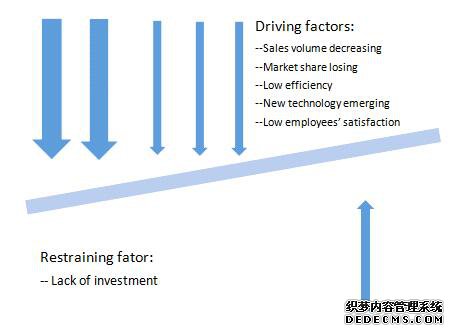
Figure 2.1 The force field analysis of the XXX Power (Shanghai)
In the figure above, it’s found that driving factors are more and stronger than the restraining ones, which indicates that strategy change is desired to take place. After confirming this, the strategy changing plan can be designed according to the analysis.
3. Mission, Vision, and Objectives
The XXXPower aims to creating new energy solution for better life for human beings. It offers high tech and customer centered products, and it’s eager to grow the business in the industry. Therefore, considering the SWOT results and five field analysis, as well as the company’s culture,the new mission, vision, and workable objectives of the XXX Power (Shanghai) are designed as below.
3.1 Mission
We offer high-tech and customer centered energy solution, inspiring customers, employees, and stakeholders in the world.
3.2 Vision
Creating advanced clean energy solution for better lives and better world.
3.3 Objectives
--Increase market share globally
--Keep continuous sales growth
--Build more photovoltaic station to improve the network
--Establish an inspiring training system and work environment for employees
--Consolidate the internal process to ensure the efficiency
4. Change Structure
Organization structure plays an important role on change management. It’s required to set a suitable structure to support the strategy implementation plan. Based on the real situation of the XXX Power (Shanghai), agents for the strategy plan are pointed. And at the same time, the functional organization structure would be kept, but some changes are made to contribute to the new strategy plan.
4.1 Change Agents
Change agents are responsible for managing the strategy plan and ensuring the implementation. As a corporate level plan, an agent from senior management is necessary. Generally, the Vice President (VP) is the first choice due to level and powers. In the XXX Power, VP has the rights to make important strategic decision and lead functional departments. Also, he has a long time experience in the company, who is widely known by most of the employees. He is the best choice for the change agent, for coordinating and monitoring the strategy implementation.
To better support the VP, General Manager (GM) would take the position of change sponsor to offering necessary help to the change agent. And change agent would directly report to GM for the implementation.
4.2 Organization Structure
The current organization structure of the XXX Power (Shanghai) is based on functions. This kind of structure focuses on the functional results rather than unified outcomes and long term relationship. It’s because that the management and performance evaluation are all made by functional units. In the current organization structure, there is not a workable coordinator or team working on those corporate level process and jobs to support the change management. Therefore, to implement the change plan fully into each functional units, a specific team should be pointed (Milgrom& Roberts, 1995).
Considering the disadvantages of the functional organization structure and the objectives of the new strategy plan, it’s important to create a combined and experienced team to work out the progress of the strategy implementation. This coordinative unit can be grouped by people from different functions, in order to cover all units of the company. As the members from different functions understand their own processes and jobs well, they are able to contribute functional views and experience. It will help the changes come into force without many conflicts with the real business. This “change management” team should have the rights to report and advise the changes at the corporate level. And they will direct report to the change agent. Empowerment is necessary for them to take the change plan into force. A simple diagram of the change management team can be found as below.
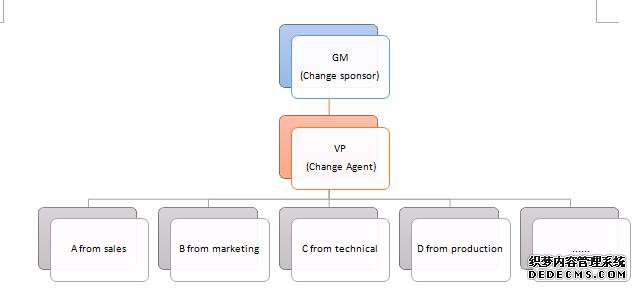
Figure 4.1 Change structure
5. Executive Implementation Plan
The executive implementation plan of the XXX Power(Shanghai) contains the different levels of strategies, resources and time schedule of implementation, and change driving factors. All those items match the SMART principles, ensuring they are workable and reasonable(Efstathiades et al., 2002). Each of them are explained in the related sections. #p#分页标题#e#
5.1 Strategy
In order to achieve the objectives in the section 3.3, it’s designed the new strategy to realize a) increasing market share globally, b) keeping continuous sales growth, c) building more photovoltaic station to improve the network, d) establishing an inspiring training system and work environment for employees, and e) consolidating the internal process to ensure the efficiency.
Combining with the SWOT analysis in the table 5.1, it indicates the new strategies focus on increasingPERC market share and vigorously expanding the distributed roof photovoltaic power station. The Focus-Differentiation Strategy is applied for the XXX Power(Shanghai) by focusing on PERC market.
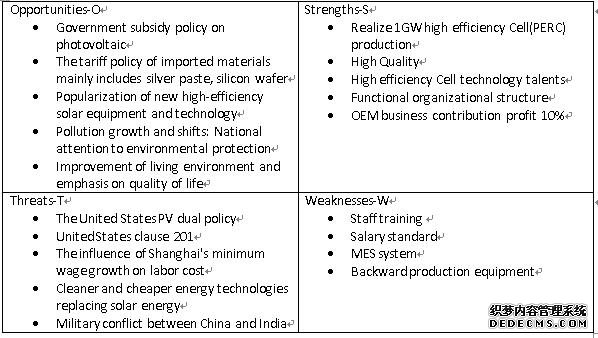
Table 5.1 The SWOT analysis
For niche market, it change the production mix by increasing the PERC percentages. Currently the production mix is 80% normal cells and 20% PERC cells. However, the profit of normal cells are only around 8%, while the profit of PERC ones are about 20%. To increase the total profits, the percentage of PERC cells is designed to be 50% of total production. At the same time, more resources and sales focus should be allocated at the PERC cells niche market, including purchasing the new manufacturing machines and system. The competitive advantage is created by improving the PERC production volume and market share. It is targeted at 30% market share PERC cells in Asia, while producing 1GW PERC per year.
5.2 Resource and Time Schedule
To implement the strategy plan, resources are should be taken into account, including task, land and capital, finance, human resources, information, timeline, and responsibility. Considering the goals and strategies, the resources required above are listed below.
Table 5.2 Resources and schedule
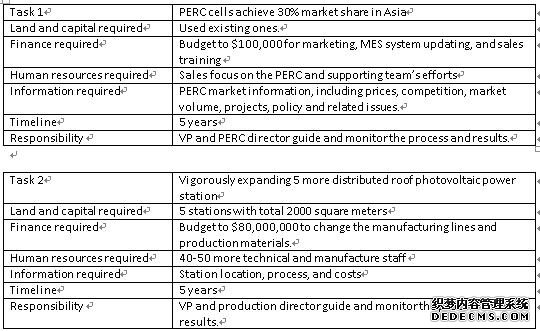
5.3 Change Drivers
The change drivers are the factors that driving the change taking place. Internal factors and external ones all could be the drivers for the organization changes. From the EFAS and IFAS of the XXX Power(Shanghai), most of the change drivers are external, including challenges of sales growth, market trend changes in global market, new government policy oftrade and tariff on photovoltaic, and new energy technology. At the same time, not competitive salary and low efficiency are internal drivers for change as listed in table 5.1.
Table 5.3 The change drivers of the XXX Power(Shanghai)

Understanding the change drivers, it’s able to design the related strategy change implementation steps and evaluation. Those drivers reflects the organization desires and they should be satisfied after the strategy changes. For example, the new strategy should match the new government policy. Also, the sales growth should be achieved after the change. More about evaluation is explained in the section 6 risk and change monitoring.
6. Risk and Change Monitoring
Change is always with risk. The change strategy process and outcomes would be monitored and evaluated by the balanced scorecard, and risk assessment and management.
6.1 Balanced Scorecard
The 4 points of success are customers, financial, learning and growth, and internal business process. These four elements structure the Balanced Scorecard as Table 6.1, designing for annual evaluation.
Table 6.1 The Balanced scorecard
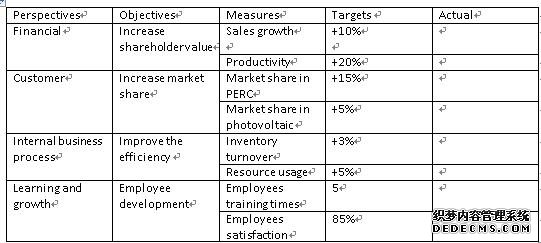
6.2 Risk Management
The risk of change for the XXX Power(Shanghai) are mainly from political, economics, production, and technology and others. The top five risks and explanation are listed by the importance order in table 6.2 below. Those factors above can bring influence on the whole industry and the company, which should be closely monitored. Therefore, the regular information sharing about those risky factors should be conducted.
Table 6.2 The top five risks

6. Conclusion
As described above, the change strategy is designed based on the five force field analysis of the XXX Power(Shanghai). The implementation plan contains the strategy content, resources and schedule, and drivers based on the SWOT analysis and Porter’s generic strategy theory. It’s believed that increasing the PERC market share and power stations would grow the business and company. However, strategy does not last forever. It should be evaluated and updated accordingly to the real situations. The suitable change strategy would bring both short term and long term benefits to the company.
7. Reference
Baulcomb, J.S., 2003. Management of change through force field analysis. Journal of nursing management, 11(4), pp.275-280.
Efstathiades, A., Tassou, S. and Antoniou, A., 2002. Strategic planning, transfer and implementation of Advanced Manufacturing Technologies (AMT). Development of an integrated process plan.Technovation, 22(4), pp.201-212.
Kruglanski, A.W., Bélanger, J.J., Chen, X., Köpetz, C., Pierro, A. and Mannetti, L., 2012. The energetics of motivated cognition: a force-field analysis. Psychological review, 119(1), p.1.
Milgrom, P. and Roberts, J., 1995. Complementarities and fit strategy, structure, and organizational change in manufacturing. Journal of accounting and economics, 19(2), pp.179-208.
The Change Models and Their Applications
Introduction
Change management is widely studied by many scholars and business professions. Some valuable models are created by scholars and consulting companies in different times, and they are applied to multiple businesses. This paper is going to discuss three famous change models, including McKinsey’s 7S model, Kotter’s model and Lewin’s model. Their applications and limitation will be explained in details to bring better understanding on each model.
Change models
Lewin’s model and application
The Lewin’s model describes the change process as three stages in figure 1, including unfreezing, changing, refreezing (Schein, 1996; Levasseur, 2001). It’s the early model of change in the history. This mode can be used to explain the process and cycle of change in the organization.
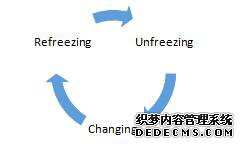
Figure 1 The Lewin’s model
This model is used to understand how change happens and offers a mindset of change process. For example, Google appreciated the “change” by keeping doing the unfreezing implementation to push the cycle, such as innovation awarding. However, it does not indicate how to handle and conduct a change to the organization. More models and tools are developed based and beyond the model.
McKinsey’s 7S model and application
The McKinsey’s 7S model was created by Tom Peters and Robert Waterman, two consultants from the McKinsey & Company Consulting in 1980s. Based on their rich consulting experience, this model has been proved to be an efficient tool for analyzing and monitoring the change management in the organization. The 7S stands for seven factors impacting the changes inside the organization, including structure, strategy, systems, skills, style, staff, and shared values. The first three factors are known as thee hard elements, while the latter four ones are so called soft elements. This model aims to answer the question “how well an organization is positioned to achieve its intended objectives” (Singh, 2013).
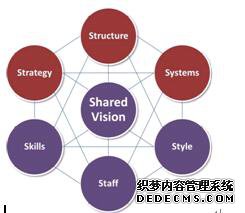
Figure 2 The McKinsey’s 7S model
However, it indicates that the 7S model only offers the guideline for the company, rather than the workable and practical implementation steps. Those factors are too board to be used as SMART objectives and direction for functional units and teams (Singh, 2013). Therefore, it’s often used for corporate level strategy analysis for big companies.For example, the 7S model was applied for IBM strategy consulting projects in 1980s(Singh, 2013). It can be used a) to examine the impacted effects of changes in a company, b) to improve the organization performance, c) to contribute to the process and outcomes of merger or acquisition, and d) to analyze the results of the strategy change plan, etc...
Kotter’s model and application
Kotter’s change model is also known as the Kotter’s 8 Steps Change Model. This model guides how to do the change management, created by the leadership and change management professor John Kotter. The eight steps and explanation are summarized as below (Appelbaum et al., 2012).
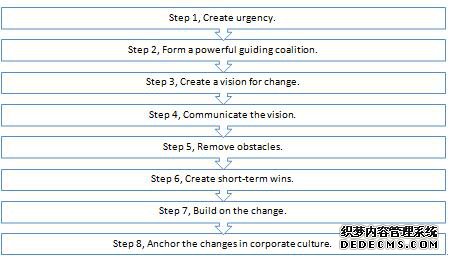
Figure 3 The Kotter’s model
This model emphases the power of people. It can be widely used to lead the change in the organization as a guideline. For example, the IT system project of an American company Kodak Alaris was used this model (Appelbaum et al., 2012). Different from the McKinsey’s 7s model focusing on organizational analysis, it works as a guide tool to lead the change by practical steps. It contributes to the real implementation plan during the change. #p#分页标题#e#
Conclusion
Due to the complicated commercial environments, corporates have to be adapt to the changing situations. It’s important to understand what and how change to make. The change models contribute to deal with changes. TheLewins’ model explains the change process, andMcKinsey’s 7s model focusing on organizational analysis to design the change, while the Kotter’s model indicates how to implement the change. However, they all have limitations, and they are applied in different situations. Before using them into an organization, it’s necessary to analyze which model is suitable and reliable.
Reference
Appelbaum, S.H., Habashy, S., Malo, J.L. and Shafiq, H., 2012. Back to the future: revisiting Kotter's 1996 change model. Journal of Management Development, 31(8), pp.764-782.
Levasseur, R.E., 2001. People skills: Change management tools—Lewin's change model. Interfaces, 31(4), pp.71-73.
Schein, E.H., 1996. Kurt Lewin's change theory in the field and in the classroom: Notes toward a model of managed learning. Systemic Practice and Action Research, 9(1), pp.27-47.
Singh, A., 2013. A study of role of McKinsey's 7S framework in achieving organizational excellence. Organization Development Journal, 31(3), p.39.
|
 |
|||
| 网站地图 |

